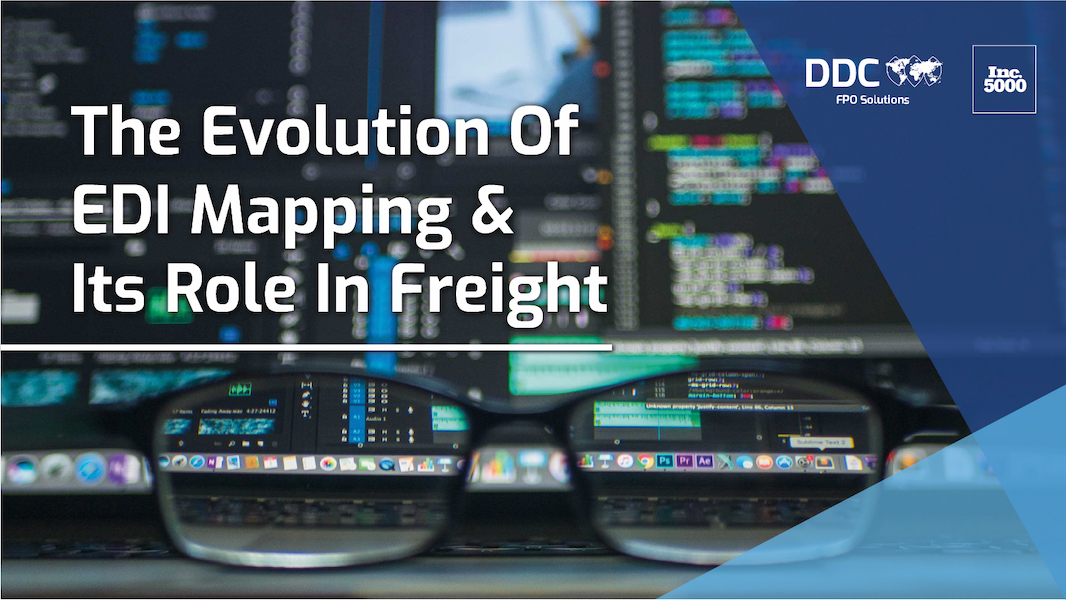The Evolution of EDI Mapping & Its Role in Freight

Electronic data interchange (EDI) technology is one of the most common ways that transportation firms facilitate and maintain automated communication and back-end processes with somewhere between 59 to 85% of companies in the supply chain using it today. Yet as the logistics ecosystem grows more complex, new technologies are being introduced, and consumer demands are driving major changes in transportation service models. Amid an ever-changing shipping landscape, how does EDI technology work, and what role does it play in freight?
A quick history on EDI
EDI is the intracompany communication of business documents in a standard electronic format. This is done with specialized software that uses EDI mapping to translate data from various formats into standard ones.
Originating in the 1970s, EDI was inspired by developments in the military, and has helped transportation companies share information by electronically communicating data that was traditionally communicated on paper.
During a standard business transaction, many points of data are exchanged between transportation companies, and EDI allows that essential information to be communicated more clearly and effectively. Examples of common EDI transactions can include:
-
Purchase orders
-
Acknowledgment of purchase orders
-
Invoice
-
Payment transaction
-
Payment receipt
How it works: The creation and integration of workflows with “Mapping”
When two companies decide to conduct business together (i.e., the carrier and shipper), an EDI workflow is established. From there, a successful EDI integration is created and can be attained when:
-
EDI documents, protocols, and transactions are determined
-
EDI data is converted into the proper formats that are easily used with back office programs
Translating internal data into EDI files enables both parties to speak the same language and communicate more effectively during the business transaction. A successful integration adheres to these guidelines:
-
Step 1: A document containing important business data is exported.
-
Step 2: The document is converted from the in-house computer system into the EDI format through mapping software.
-
Step 3: The document is processed through EDI processing software to ensure accuracy and the data is transmitted to a value-added network (VAN) via a secure communication protocol or transmitted directly to the client.
Due to the broad spectrum of investment levels and types of technology by different supply chain stakeholders, EDI integration with Legacy systems is often considered easier as compared to Application Programming Interface (API). Beyond transportation and logistics, it is estimated that 80-90% of business-to-business traffic is conducted through EDI – including sectors such as manufacturing, retail, finance, healthcare, and more
EDI's role in freight
EDI technology helps transportation companies transfer data into a much simpler, automated, and standardized format which allows for efficiency, accuracy, and connection. EDI mapping automatically sends data to proper internal systems which eliminates the need for manual processes and allows transportation providers to better communicate with their shippers.
Looking ahead, the coronavirus pandemic and trade complications – such as volatile tariffs and changing customs regulations – have exacerbated the existing IT gap in many ways, particularly for the logistics industry.
According to Adapting to a Pandemic: Freight Market Budget & Priority Shifts in 2020, over 41% of industry leaders shifted their priorities to updating their IT systems so that they could:
-
Stay competitive in a highly aggressive industry
-
Enforce better business transactions to keep shippers coming back
-
Adapt to the next generation supply chain to be relevant
-
Employ better integration methods with 3PLs and TMS systems
EDI infrastructure has come a long way since its inception. As industry-specific requirements and laws of commerce evolve, EDI data formats will adapt. From the new PEPPOL (Pan-European Public Procurement On-Line) protocol established by the European Union, to complementing the “Big 3” – Blockchain, AI and IoT –, mapping software is already being applied in new ways to support "bigger picture" initiatives.
According to a recent IBM report, by taking a collaborative approach to EDI with these other technologies: “Organizations will be able to share more data through IoT mechanisms, based on a single shared version of the truth enabled through a blockchain ‘backbone,’ and facilitated by AI technology that can streamline root cause analysis and introduce new forms of automation.”
Yet, as with any technology, it’s important to choose the EDI mapping software that meets your specific needs. Some tools are easier to use than others, but your best choice should deliver an integrated approach to your entire business system, providing increased visibility into operations and concurrently improving customer service.
Since EDI is inherently complex, it’s also important to keep EDI interface files, processes, and systems up to date and accurate. Every company has different formats and/or requirements. Yet EDI will continue to play a primary role in the freight industries as it offers dependable benefits when implemented correctly and optimized for interoperability with emerging technologies.
However, implementation is easier said than done. Due to its intricacies and little room for error, many in transportation and logistics are leaning on third-party experts to manage their EDI capabilities and ensure business process success.
Connect with Us
DDC FPO has over 15 years of delivering success to the freight industry. Explore how we can help you with EDI and IT outsourcing.
How Can We Help You?
Get in touch to learn how we can support your success.
Get Started
